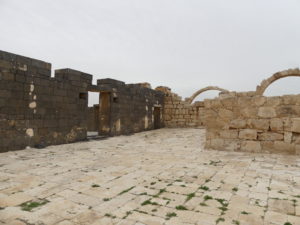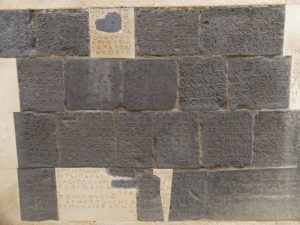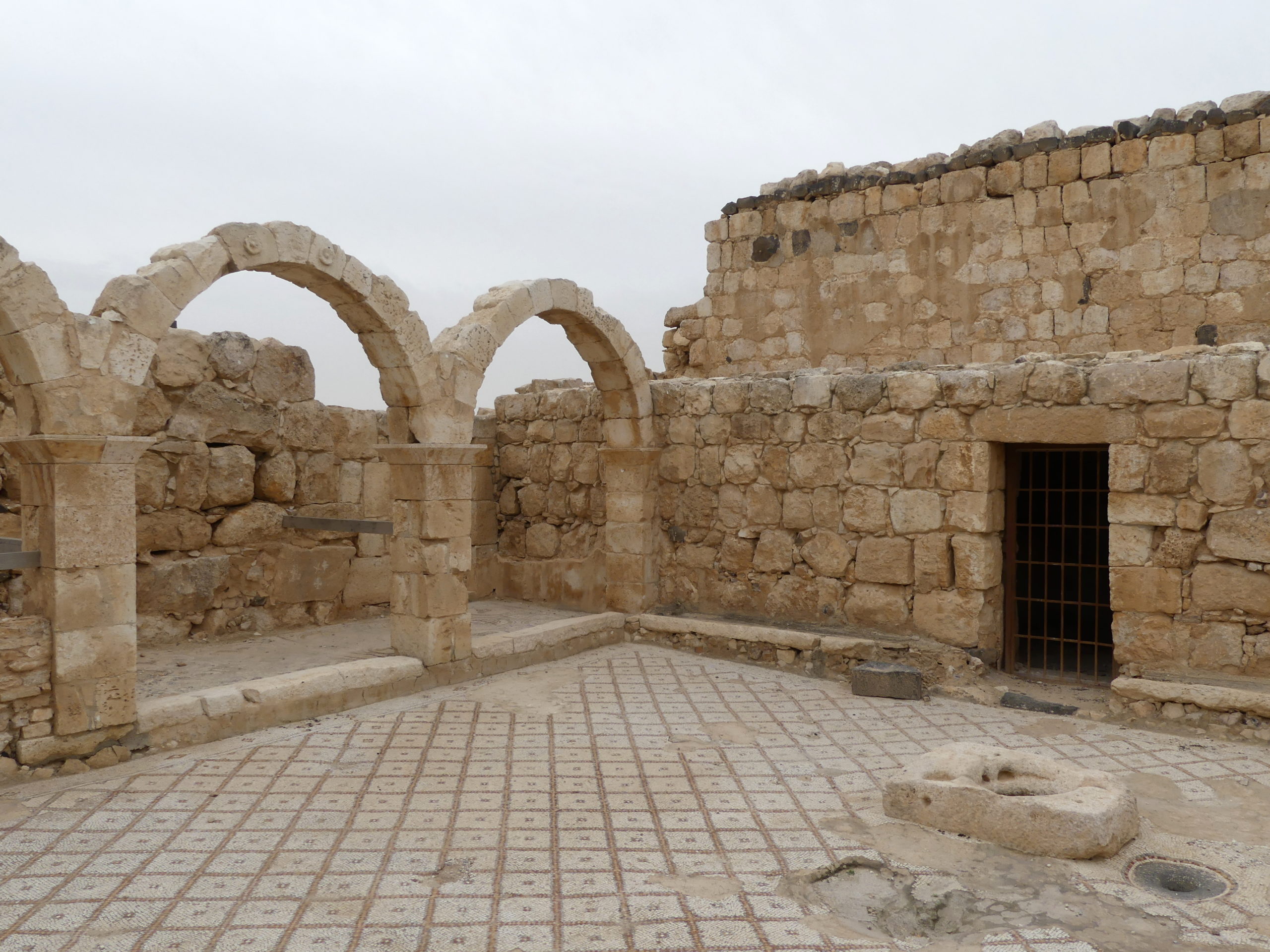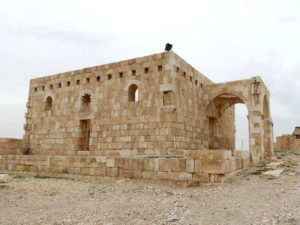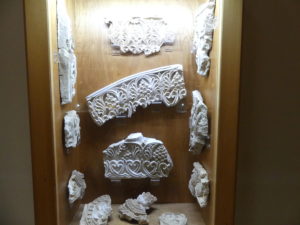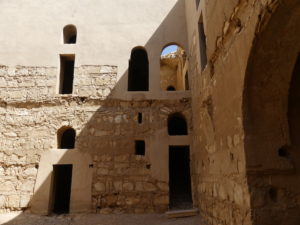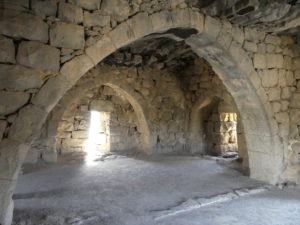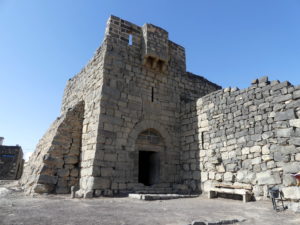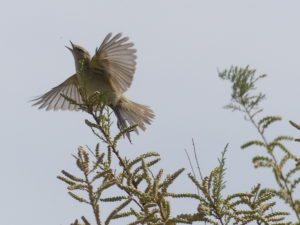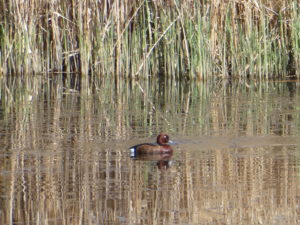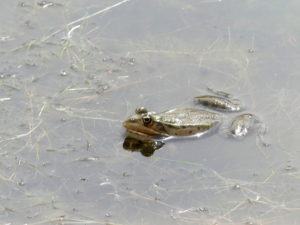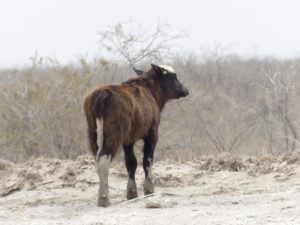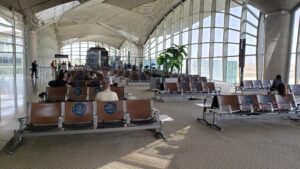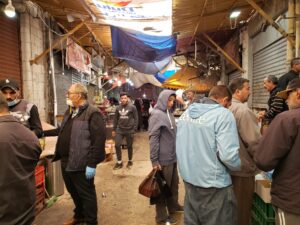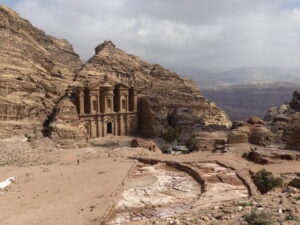Why do ruins attract us so much? One reason is confronting history in the flesh, so to speak, listening in person to the stones and carvings from thousands of years ago. Related to this is discovering what others have learned about the stories represented in these stones. And then there’s the play of imagination, trying to picture how a place appeared in the past and how its people lived.
Here are a millenium or two of the bare ruined quseirs, castles and forts – and more – we visited in northern Jordan.
The first millennium AD at Al-Hallabat
The old desert fortress, Al-Hallabat, did demand a bit of imagination from us, but it surely stirred our synapses because we could find so many layers of history in one place. Here succeeding empires established an outpost on just enough of a hill to monitor a broad panorama at the edge of their realms.
Though not much remains from the Nabataeans of Petra, the Romans affirmed their power with walls still standing today.
Three layers of history in view. On the Roman foundations, the Umayyads added their limestone blocks. They also retained the black basalt stone walls that were added by the Byzantines when they converted the fort to a monastery by modifying and adorning what the Romans built. Basalt is plentiful in the desert region due to volcanic activity in the past.
In preparing al-Hallabat for tourist visits, the supervisors assembled an attractive array of basalt blocks (volcanic rock) with Greek inscriptions that were laying about the ruins. They date from the first half of the first millennium.
This fragment of an early piece of mosaic flooring shows one of the endemic animals of the region, the Arabian oryx, several of which we saw in Azraq’s animal reserve (see later).
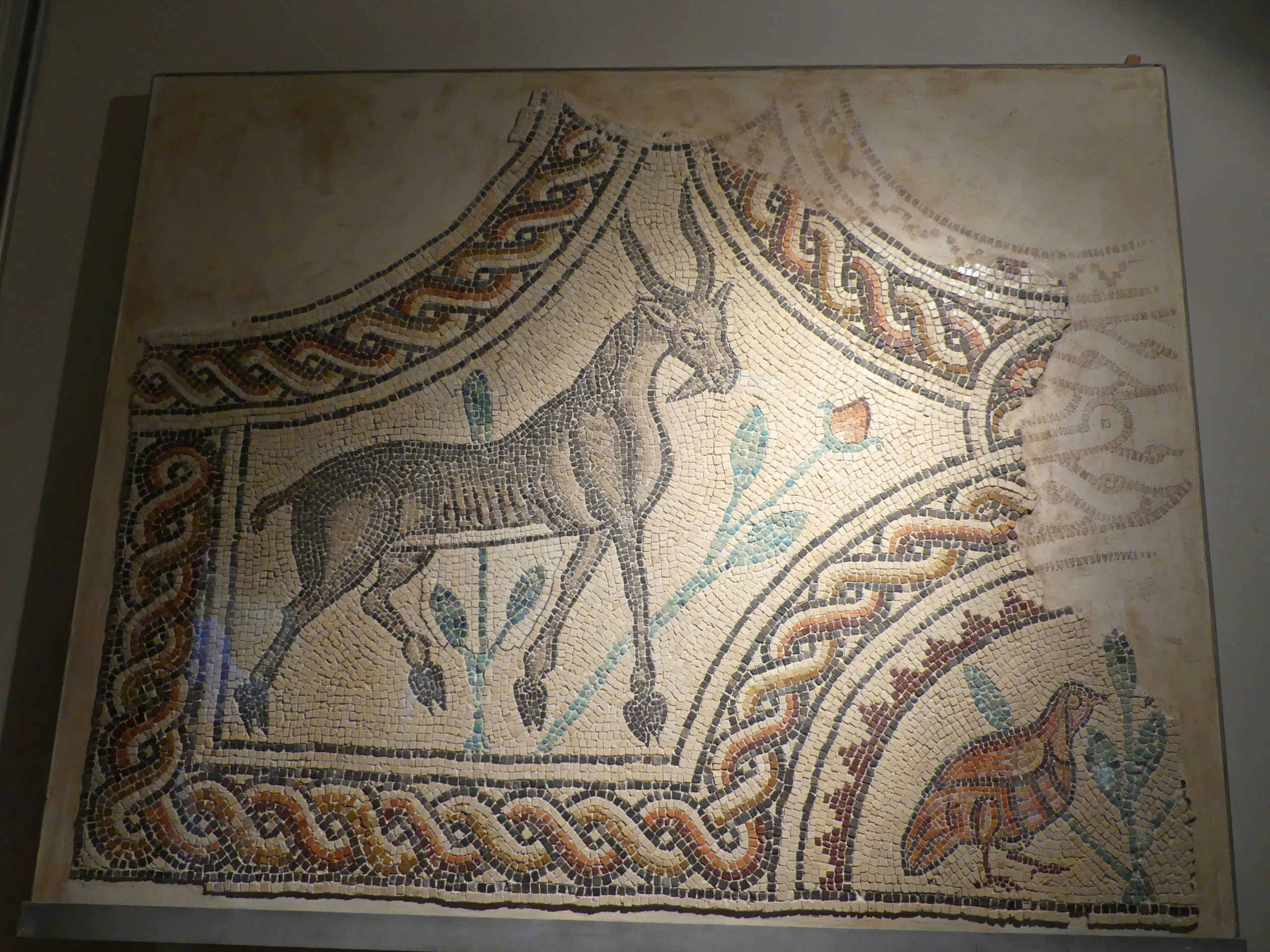
Lean and elegant, this image seems to exhibit a strangely bemused facial expression.
It doesn’t look like much of a hill, but Hallabat’s location provides an expansive view over the flat desert surrounding it. So it was an ideal spot for a fort.
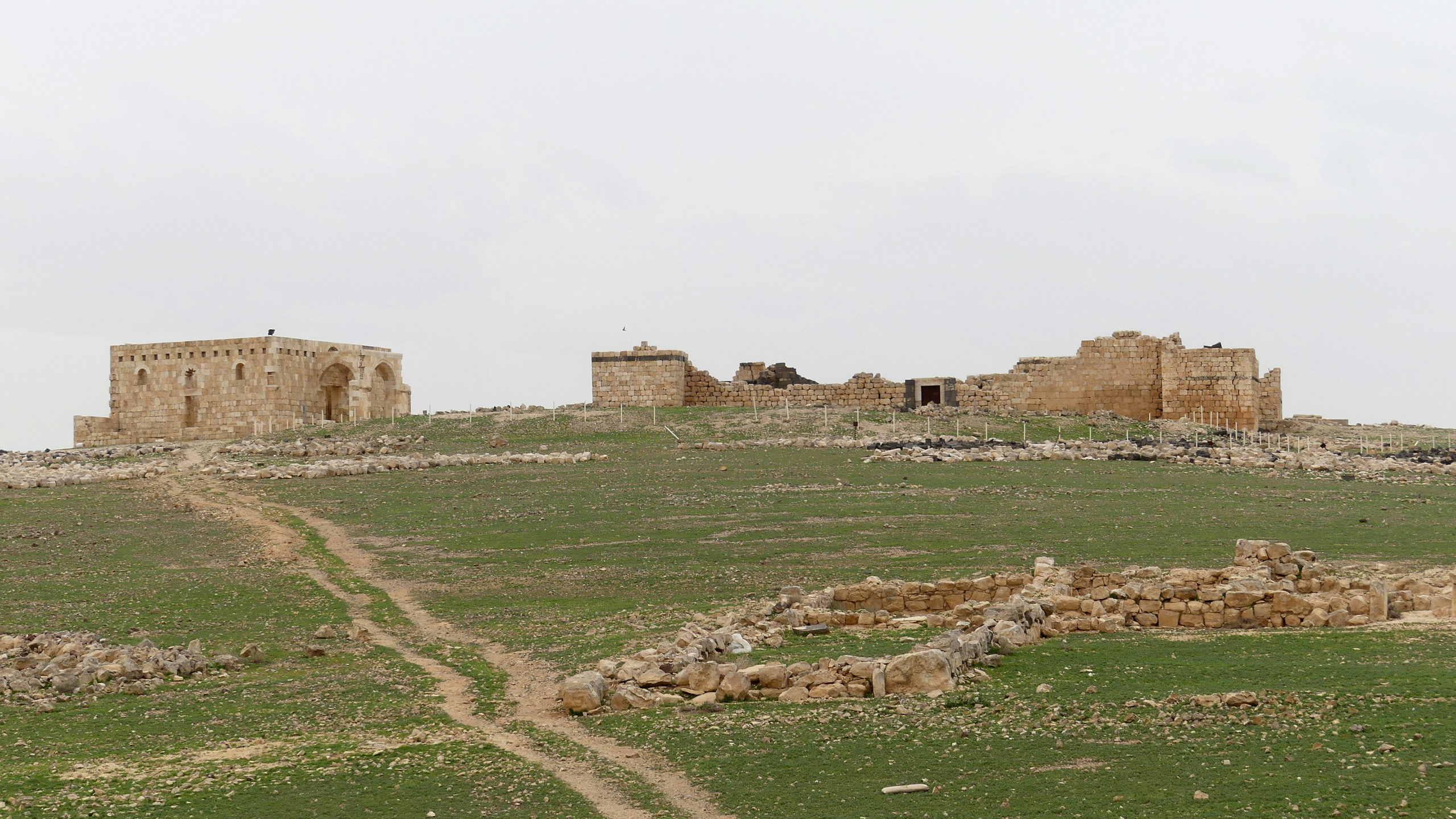
Then a leader of the Umayyad Muslims repurposed the fort as a palace along ancient trade routes, just as we saw in the quseir described later. The Umayyad remake went all out: an elaborate system supplied water for drinking and bathing; four large towers rose from the corners; and pleasurable decoration abounded. A mosque rebuilt by Spanish archeologists is to the left and the remains of the remains fill the frame to the right.
Umayyad columns raise their arches above an old Roman mosaic floor
The interior of the Umayyad mosque was constructed of rough limestone blocks with decorative arches as windows on each wall. The central arch, with the circlets, is an unusual version of what is called a cusped arch.

More re-created arches demonstrate the procession of rooms and doors for the Umayyad palace.
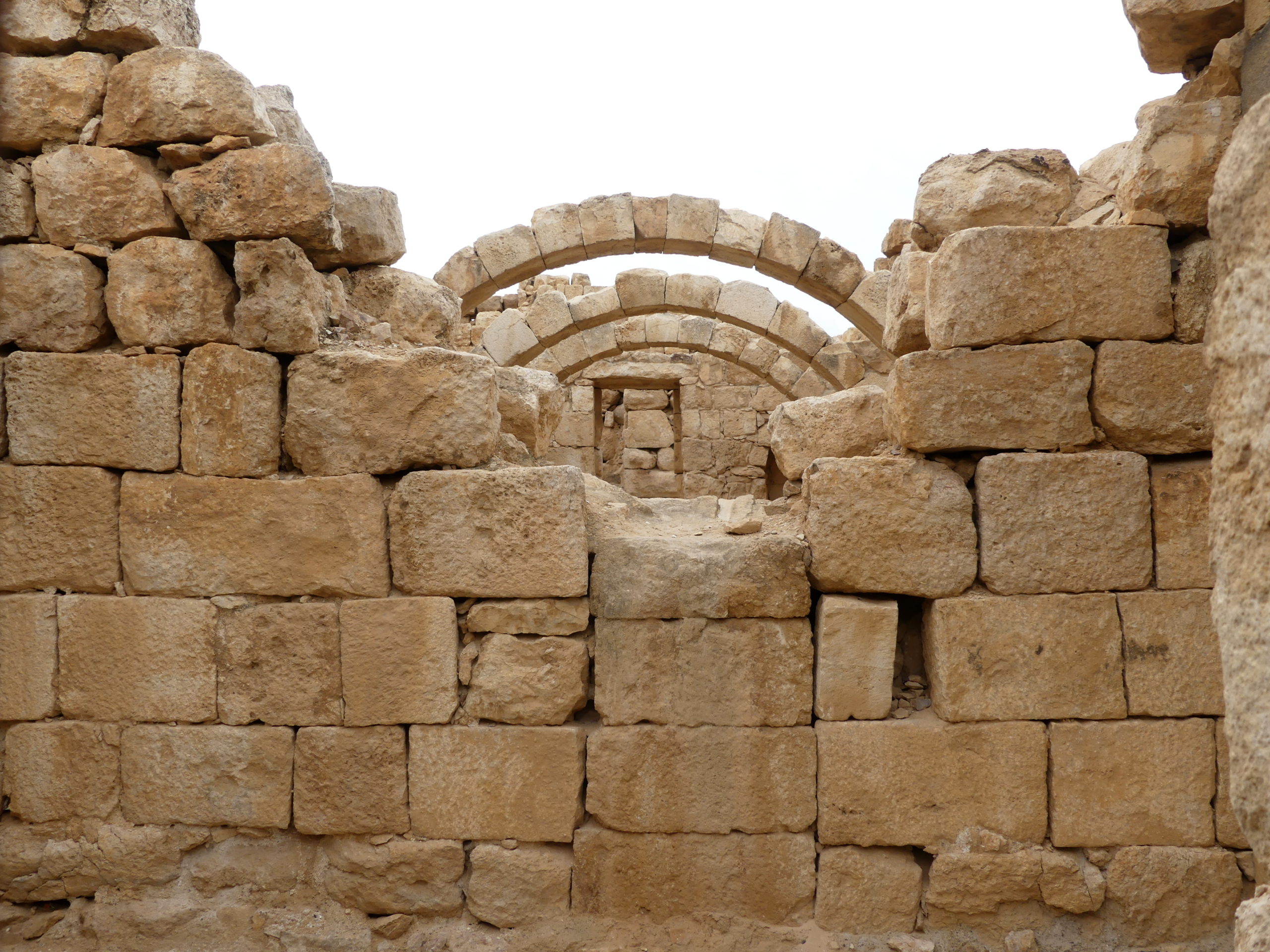
The palace seems very plain now, but these examples of decoration, stored with other goodies at the Hallabat museum, suggest how aesthetically pleasing the place must have been in Umayyad times.
A thousand years later, we could happily putter around what’s left from these empires’ 1000 years of control.
8th century fortresses as inns, Jordan’s outer desert
A number of so-called “small fortresses” or Quseir in Arabic, still sit along the ancient trade routes on the vast flatlands of Jordan’s Eastern Desert near the Azraq oasis. These 8th century structures are among the earliest examples of Islamic architecture, built during the ascendance of the Umayyads, the dominant Muslim power here at the end of the first millennium. Apparently they were never forts, but more likely started as princely palaces and inns, for the delight of their nomadic visitors.
Qasr Amra
Qasr or Quseir Amra, a UNESCO World Heritage site. This hammam, the baths, is the only remaining structure from a complex that served as a royal retreat in the 8th century, and possibly an inn.

The glories of the hammam at Qasr Amra are the frescoes within, frescoes celebrating daily life and the delights of the world, as well as politically charged praise of Umayyad ascendance. This fresco, occupying a long wall in the entrance hall, is one of several there honoring hunting (top panel), with delightfully rendered animals speeding along.
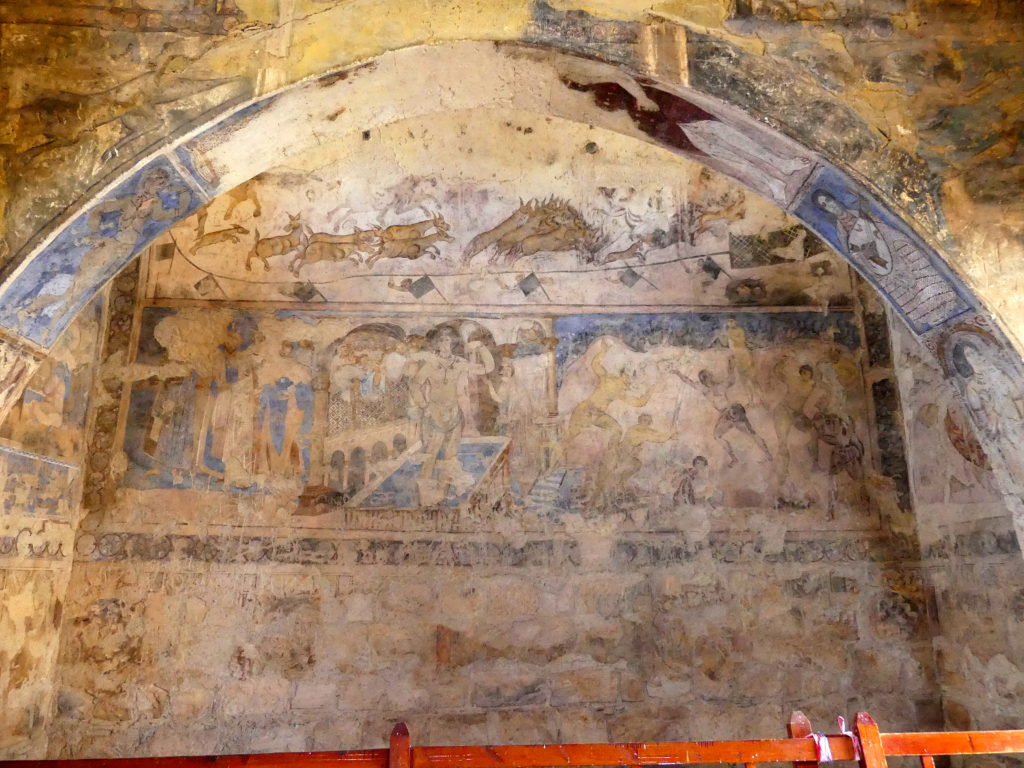
The central panel shows a famous cadre of royalty to the left, the so-called “Six Kings,” as well as a robust garden party of young men to the right. In the center, a half-naked woman rises from her bath like a Botticelli Venus. On the arch at the upper left, another partly dressed woman dances for the onlookers.
Similarly, this half-naked serving woman, larger than life, decorates an arch in the Qasr Amra baths.
Perhaps the most splendid display of Qasr Amra is its representation of 35 constellations applied to a dome in the baths, the earliest known depiction of the night sky on a hemispherical surface.
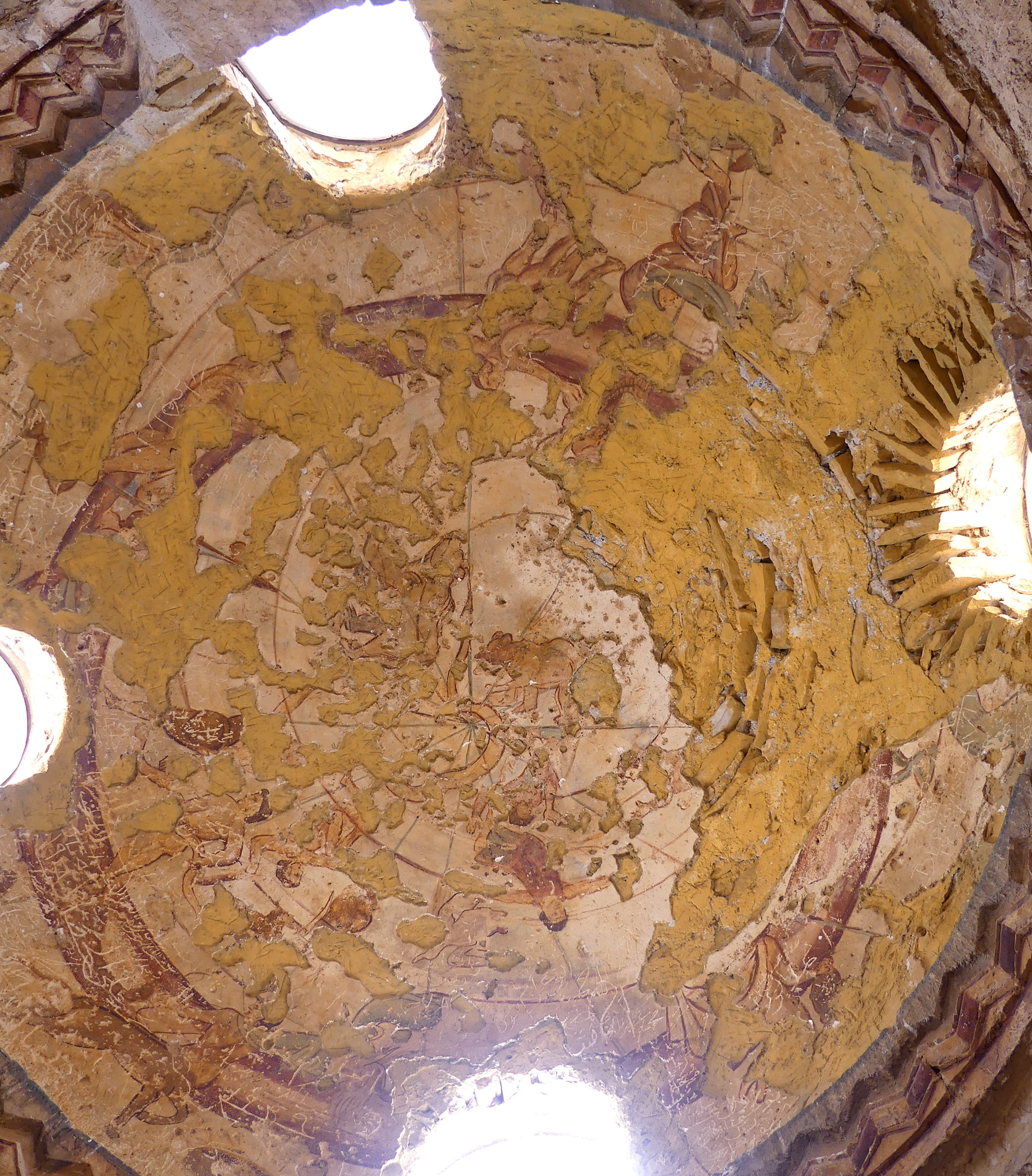
Look closely at the Great Bear in the center, the rays of the sun on the eastern window to the right, and some of the other zodiac figures around the edges, all rendered in great detail. The dome hovered over the hot water bath in the hammam, an early version of a heated pool under the stars.
To us, the most evocative and mysterious of the frescoes in Qasr Amra is this image of a man pondering – or is that ogling – a figure that might be dead or just asleep.
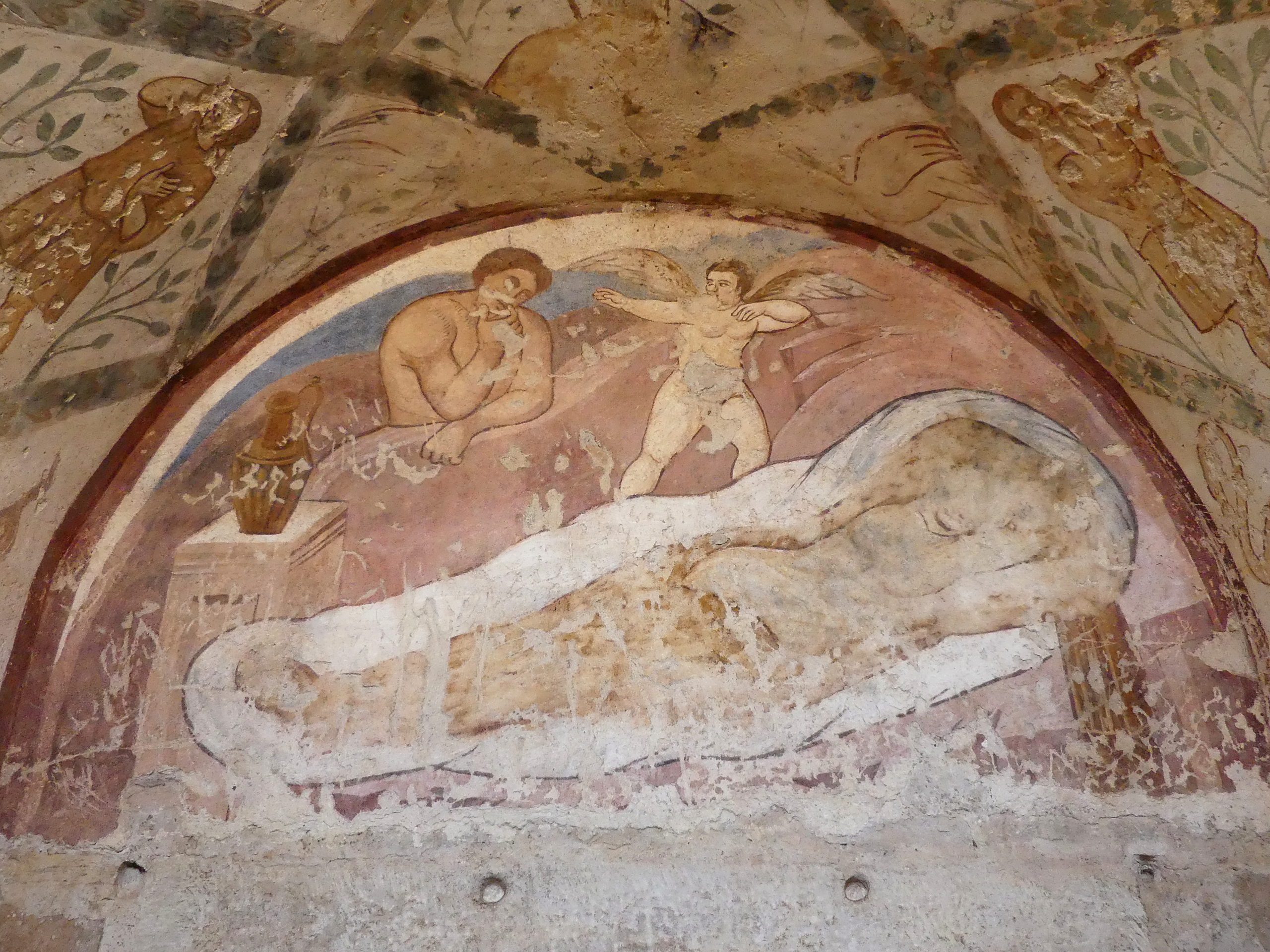
A gesturing figure like Eros/Cupid seems to invite him further. The style reminded us of early Picasso.
By contrast, within the bathing area of the hammam, this cylindrical ceiling adds naturalistic scenes of daily tasks and camel journeys.
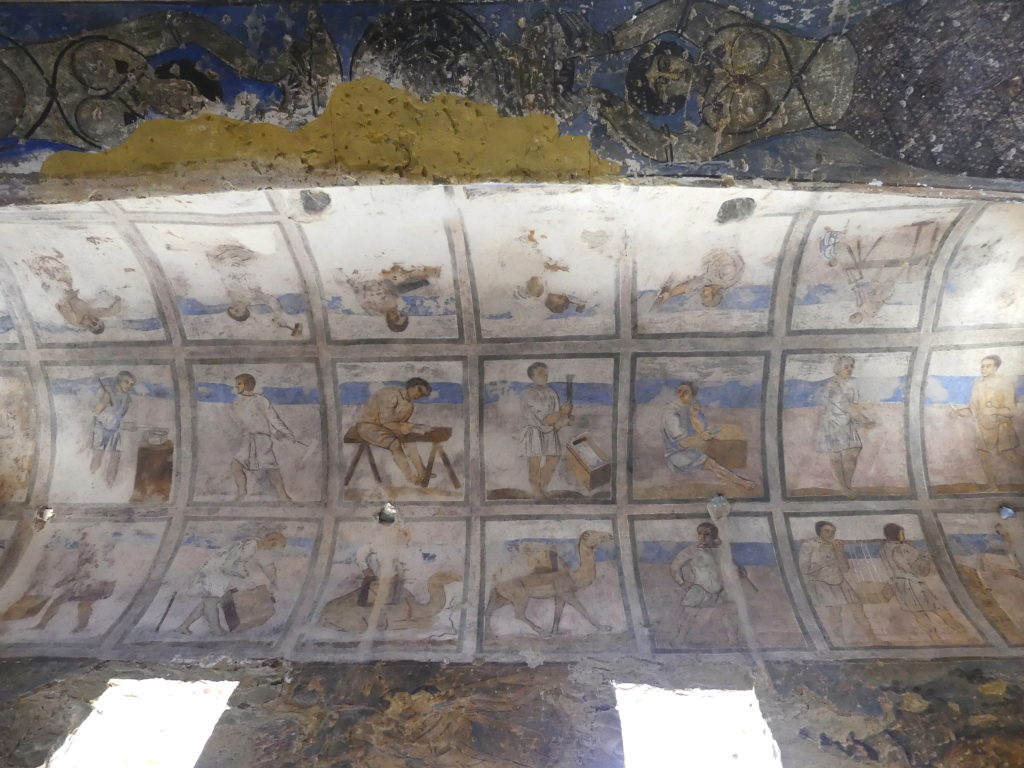
Qasr Al-Kharanah
A twenty minute drive from Amra, is the more puzzling Qasr Al-Kharanah, a huge structure of 60 rooms laid out on two levels like an intricate, well, puzzle. Though it sits on a slight hill, the surrounding terrain is mostly flat scrub desert to the horizons.
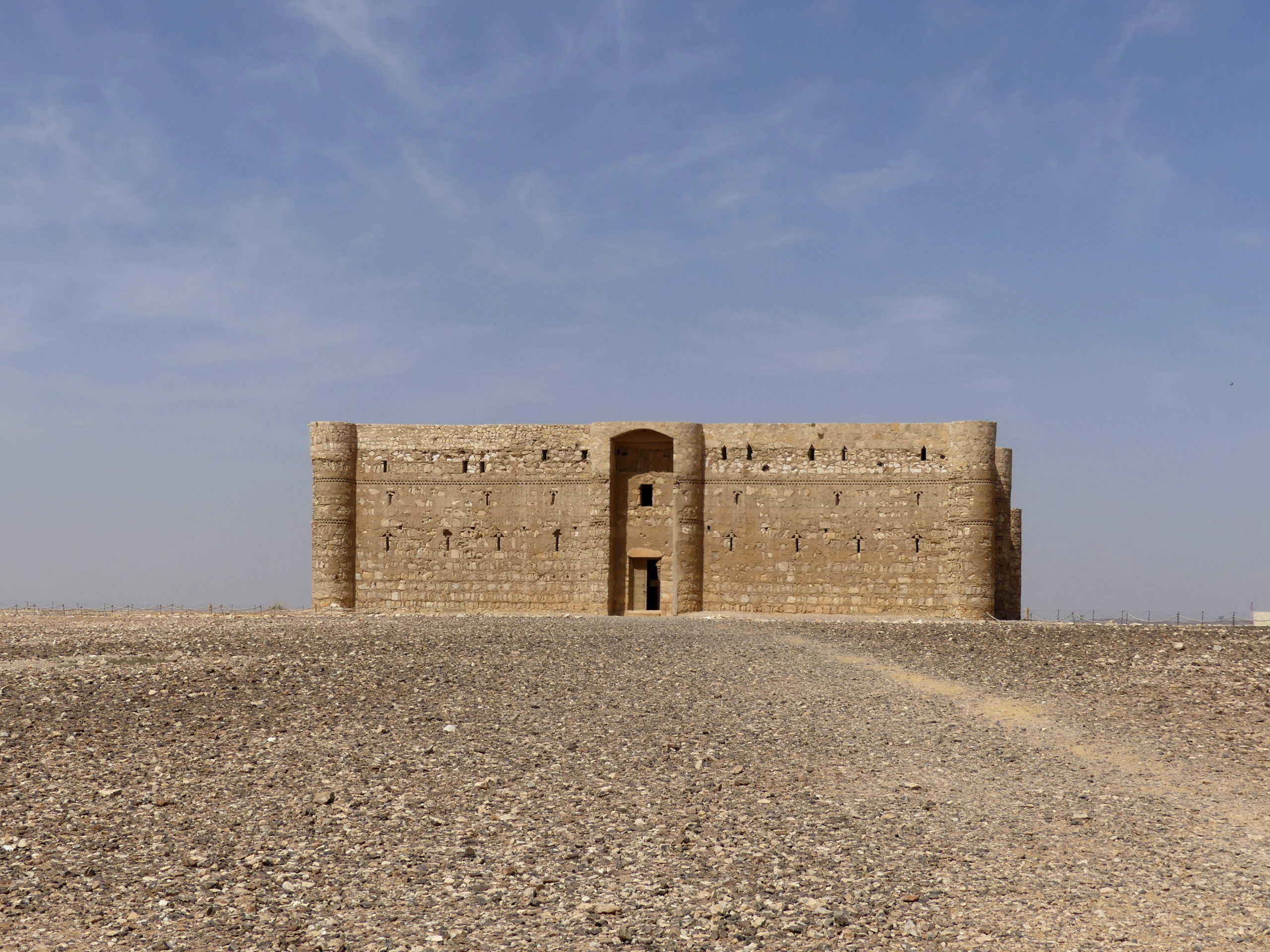
This may look like a fort, but it is unlikely to have served that purpose. Perhaps rather a meeting space for Umayyad leaders or an inn.
The interior courtyard of Qasr Al-Kharanah with windows of different forms hinting at the many stylistic influences.
Most of the rooms at the 60-room blockhouse of Al-Kharanah retain little ornamentation, but this play on arches and columns – apparently derived from Sassanid style – was one of the most engaging.
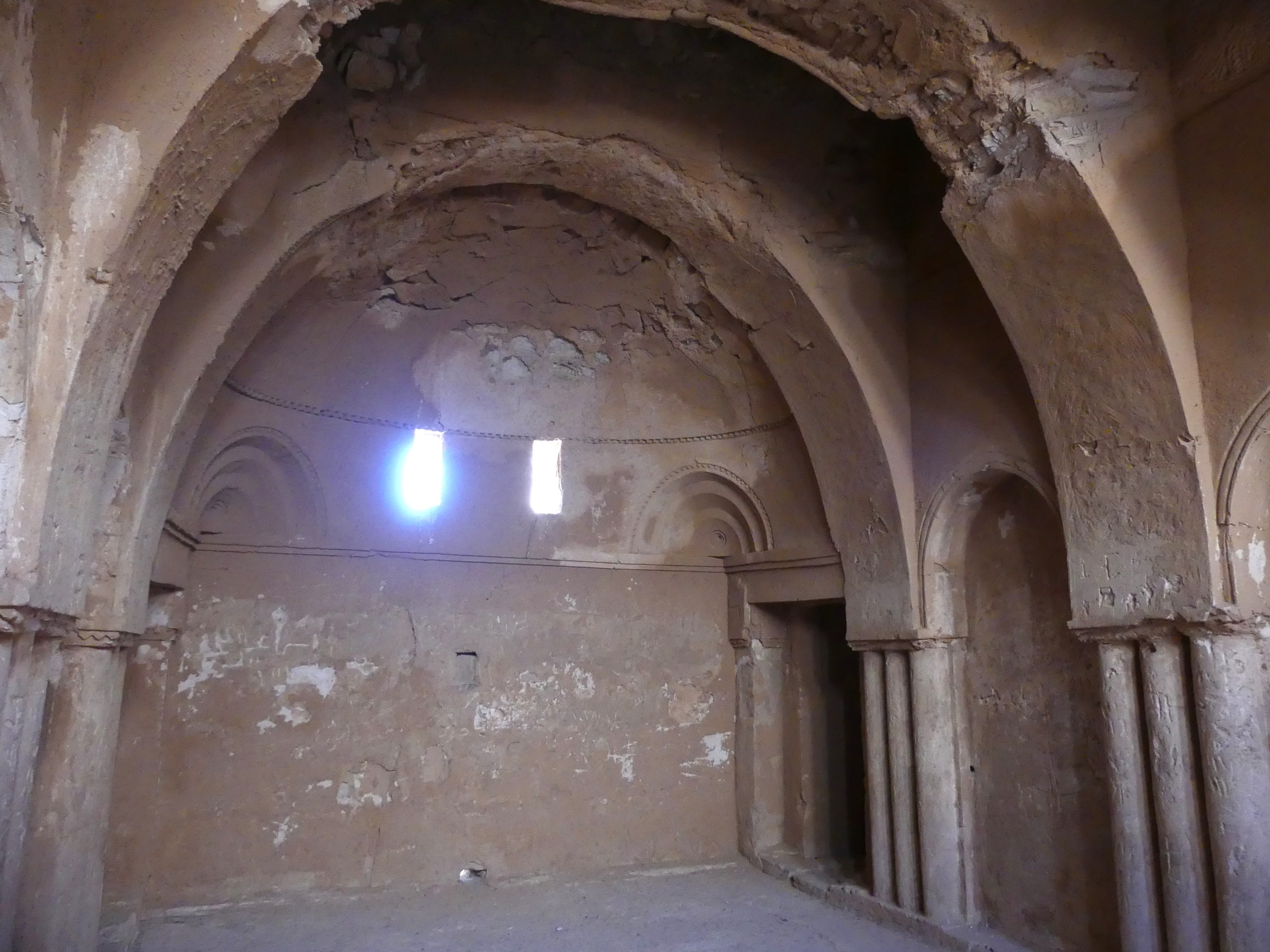
Turn of the millennia: Crusader castles
Another slice of Middle Eastern history from about 300 years later – the stuff of many legends – is visible in Jordan at the remains of several castles used by the Crusaders (or Franks).
The Franks rebuilt and expanded these forts atop those of the Roman and Byzantine eras in order to defend the Holy Land territory seized from Islamic rule. For about a century starting in 1095, in a half dozen or so crusades, European forces took on the quasi-religious task to regain control of Palestine, even though all faiths had lived there peaceably together under Muslim rule.
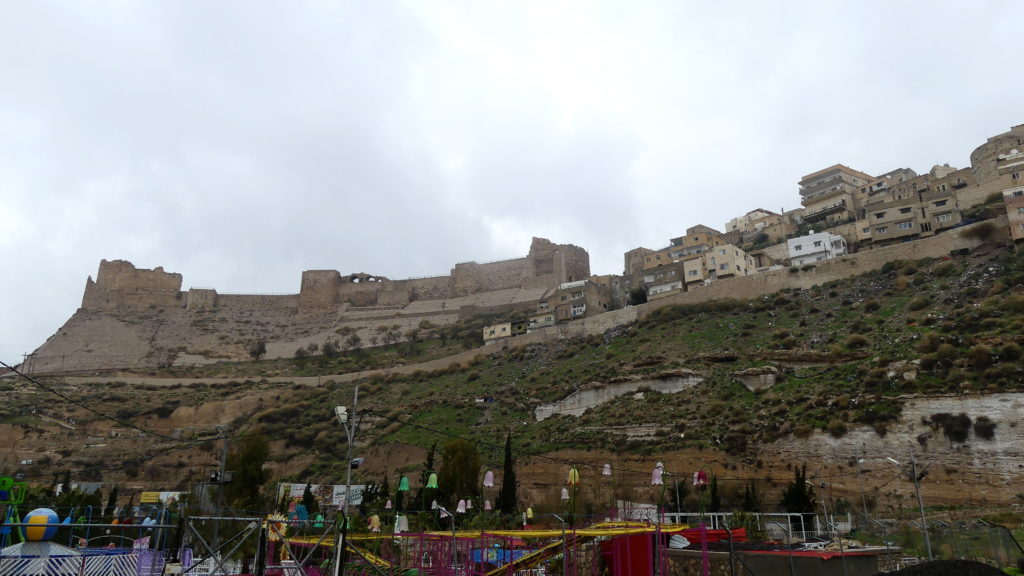
We found three of the most interesting castles along the line of defense up the center of what is now Jordan, including the astonishingly massive Karak Castle. By the end of the 12th century, Saladin, or Salah ad-Din (“the goodness of faith”), was powerful enough to defeat western forces and restore Islamic control in the area under his Ayubbid Muslim dynasty. In subsequent centuries, the castles defended Ayubbid control until they fell into disuse and ruin.
Karak
Karak Castle – a blend of European, Arab and Byzantine styles – physically imposes its will over the valley below and the surrounding countryside. It was one of the first of the Crusader castles, and its overthrow by Saladin marked the end of the Crusaders’ venture. The castle stretches about half a kilometer across the top.
The three apparent levels of the castle keep at Karak, the defensive post of last resort.
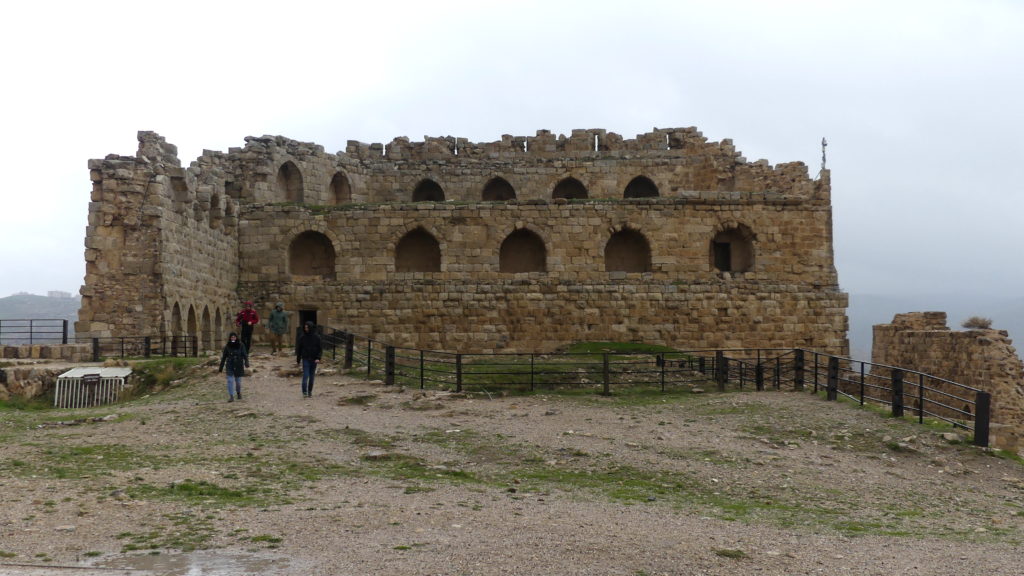
Notice the narrow slits on top for shooting at attackers. What you don’t see are the three or four levels below it cut from the rock of the hill.
A side view of the many levels below the center of the fortress, the keep, and its prospect over the valley.
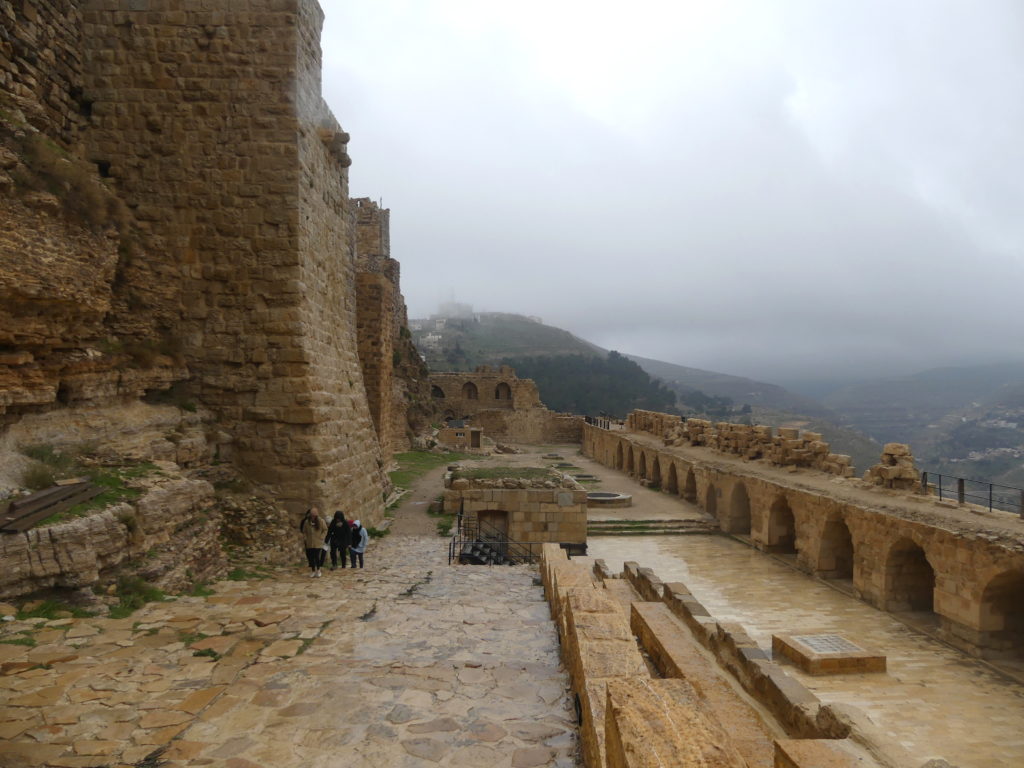
In addition to several large vaulted halls like this, we could wander up and down many levels connected intricately by obvious and hidden passageways, and that is just within the remains of the partly ruined castle.
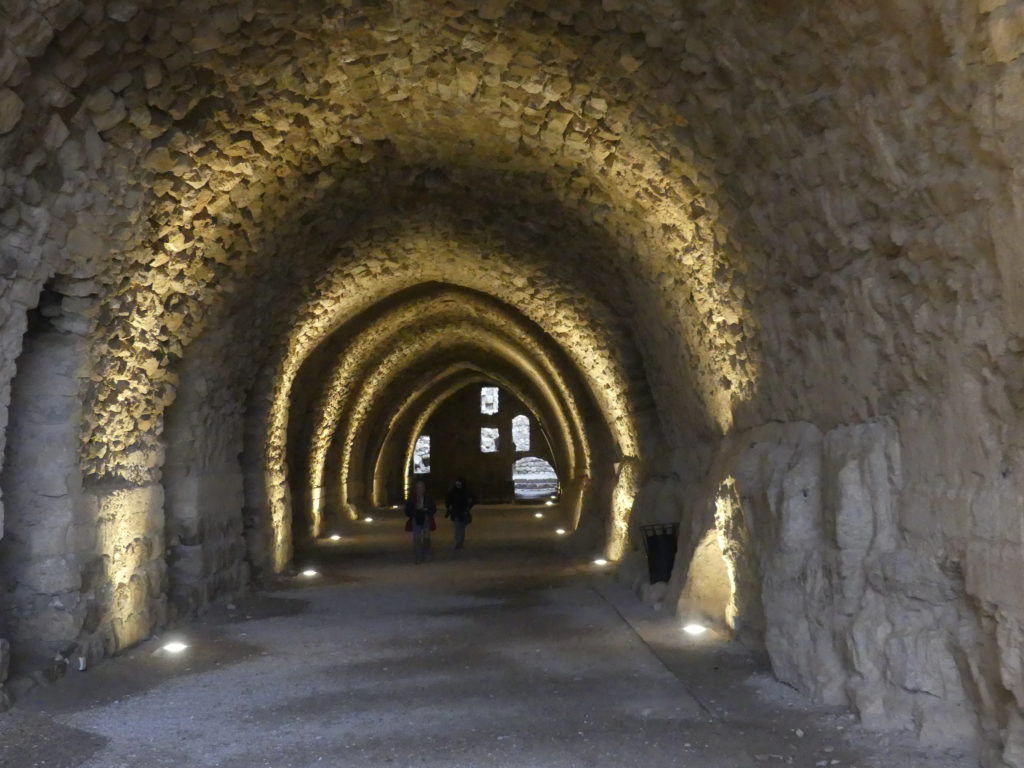
At the far end of the hall, you can see one of the oddest entry walls, an odd assortment of doors and windows. At the other end, you gaze over the precipitous drop to the valley below. Somewhere out there, they say, lie the spots where Sodom and Gomorrah were swallowed up (see the Biblical post).
Shobak
Shobak Castle was another of the important Frankish castles during the Crusades. We tried to raise an assault on the fort it during a much nicer day than the rainy one on which we visited Karak.
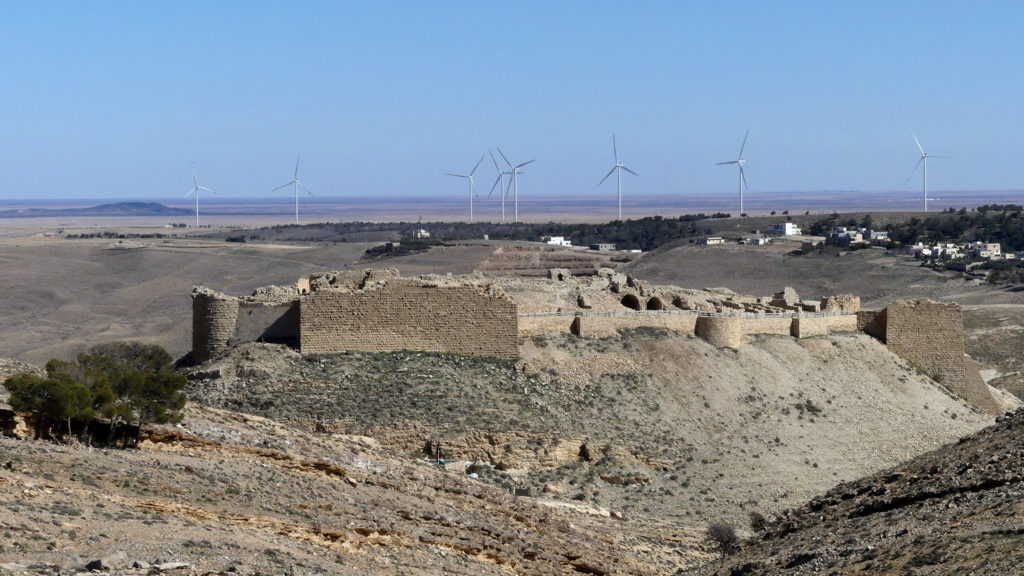
Alas, the management had closed access in order to upgrade the road to the fort. We rode away defeated. Nor did we attack the windmills waving at us.
Ajloun
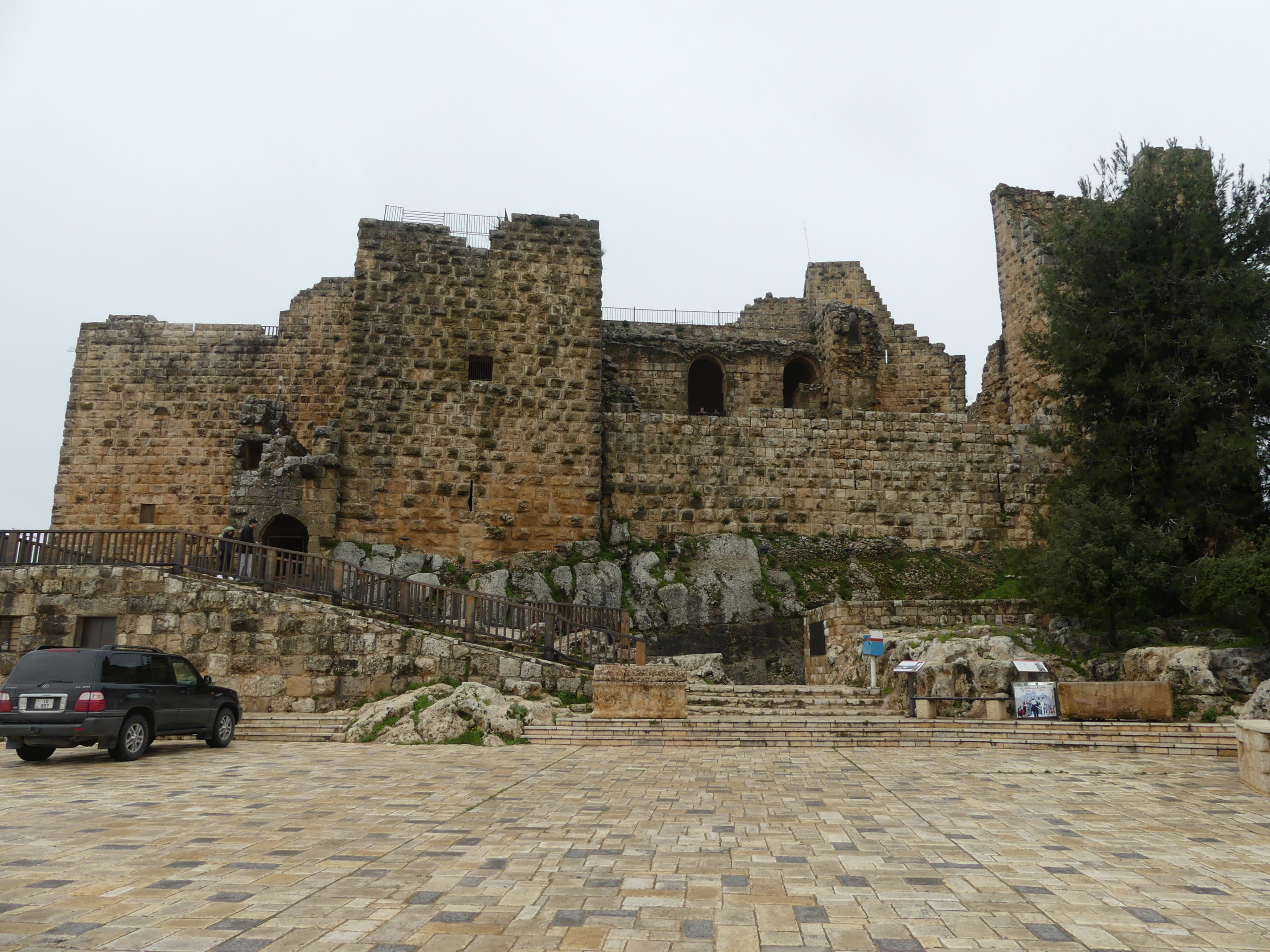
On a day just as wet, chill and miserable as the one we spend at Karak, we wondered whether Crusader castles might not bring upon themselves accursed weather.
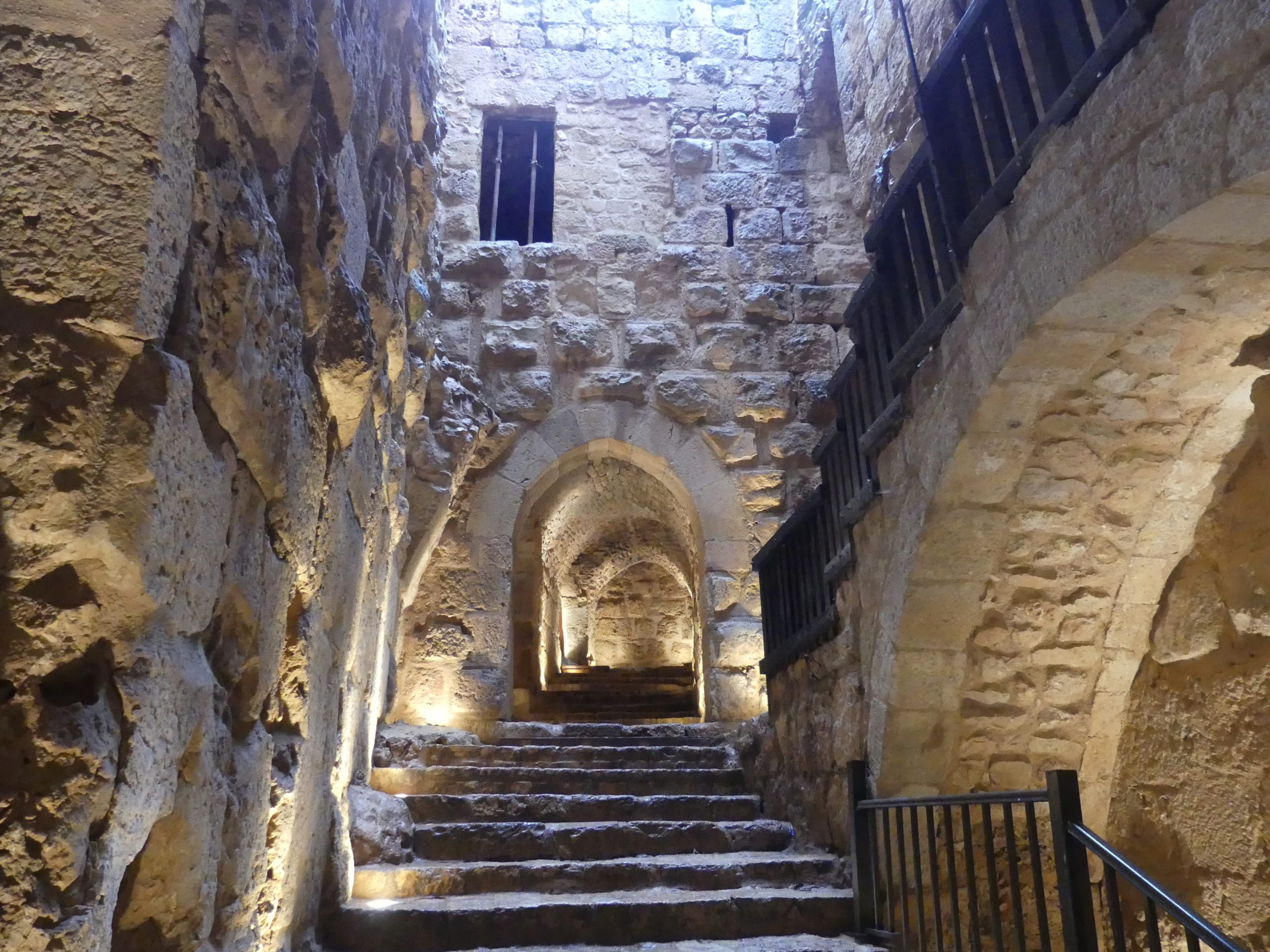
Smaller than Karak or Shobak, Ajloun Castle was a bit more of a showpiece than the intricate maze within Karak. Most of its several levels were excitingly lit on the inside, dramatically showcasing numerous barrel-vaulted rooms and passageways.
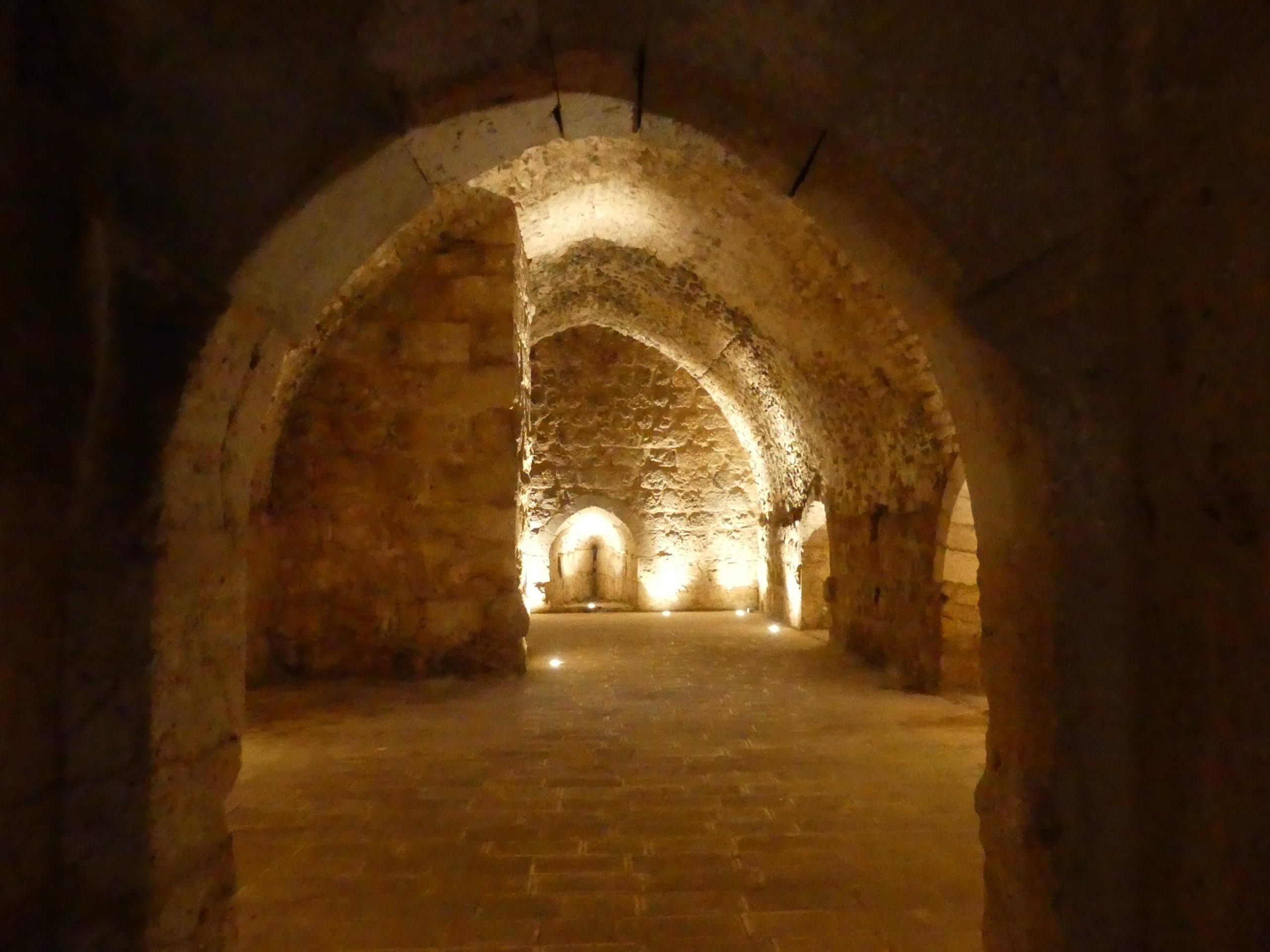
These, and the mostly dryer conditions inside the large rooms, gave us a host of opportunities to ooh and aah in an atmosphere that surely felt medieval.
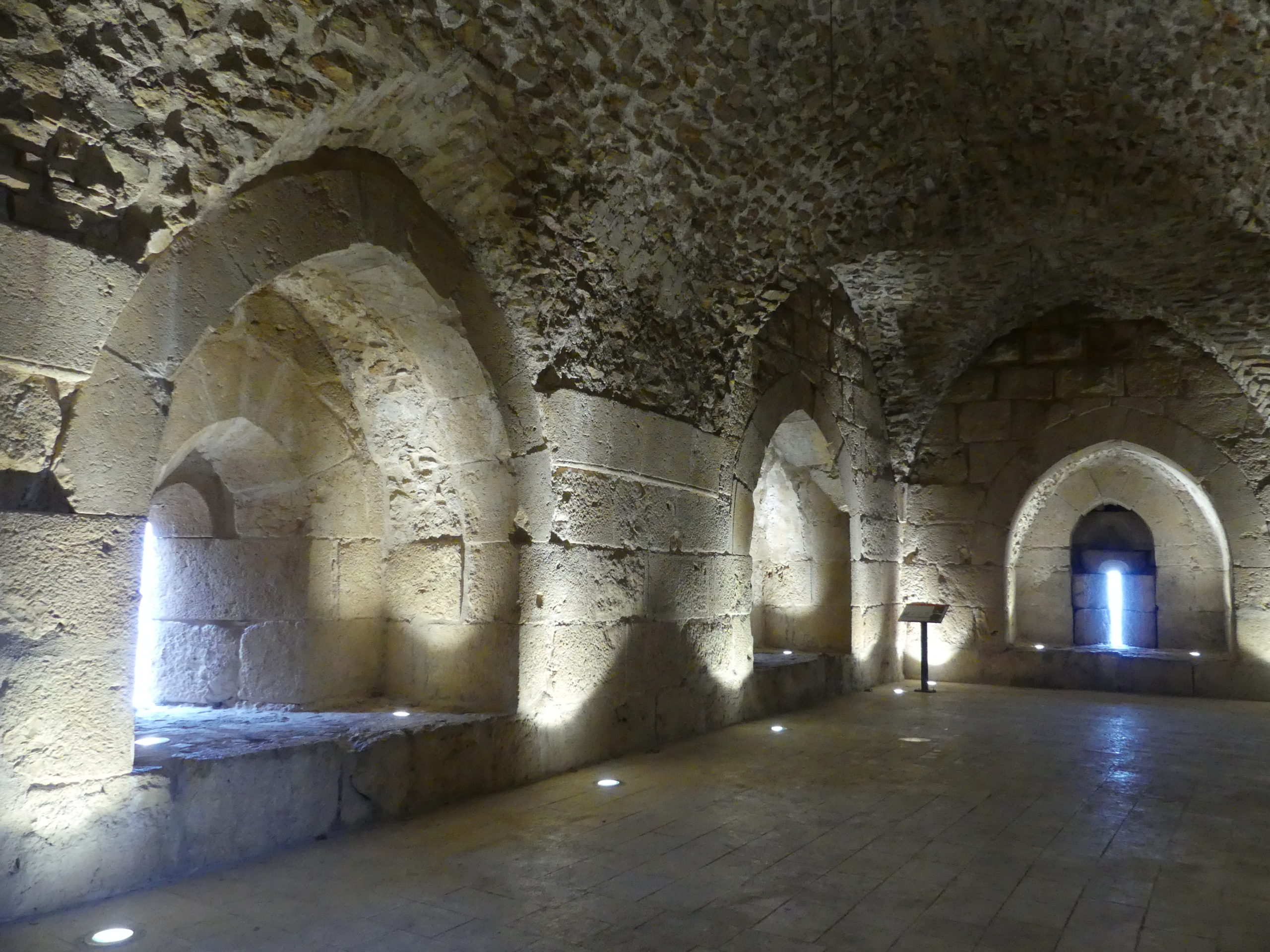
Azraq
Driving for hours, we saw only flatland, scrub desert with the horizon always way, way off in the distance. The scattered, low-lying quseir were barely noticeable as we went by them. And then, after an enormous interchange where two highways meet, we came upon the ancient oasis of Azraq.
Well positioned on the desert frontier at the substantial oasis, the “blue fortress” Qasr Al Azraq (named for the water and sky color) served for Ayyubid Muslim defense against the crusaders when it was three or four stories tall. Now it has been submerged within a small town outside of Azraq, easy to miss as one drives by.
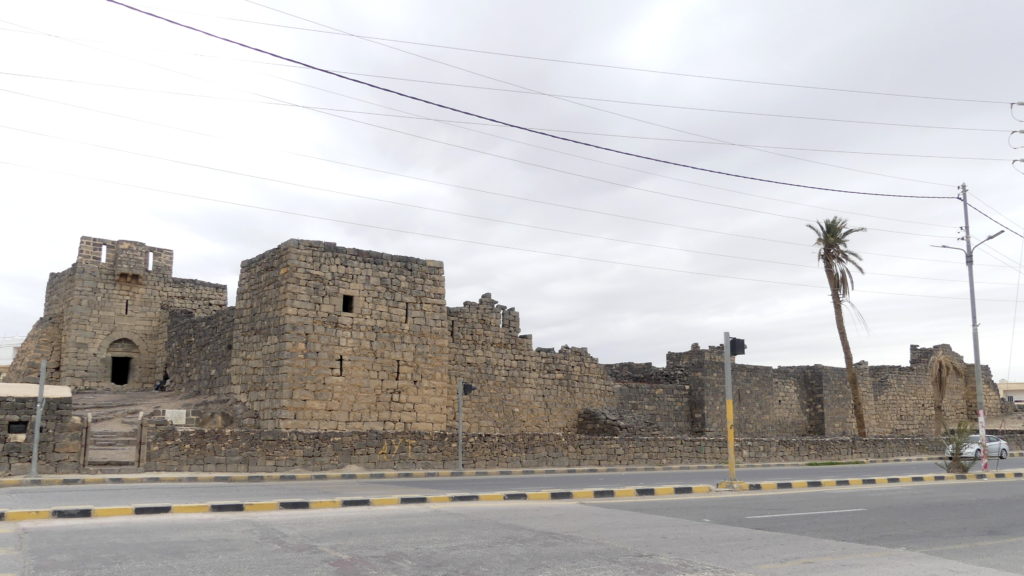
It too had been re-purposed a number of times by subsequent empires. It likely began with the Nabataeans of Petra fame, then served the Romans, Byzantines, the Islamic empire confronting the Crusaders, and lastly the Ottomans.
Here are arched living quarters for the Ayyubid forces at Al Azraq.

The black rock throughout the remains is basalt, a plentiful volcanic rock in this desert and a building material they typically used for enhancing and expanding such forts, notably Al Hallabat.
Eventually, inside what remained of the walls by the 20th century, Azraq became a rubbly hideaway on the edge of the eastern desert for TE Lawrence (of Arabia) and the Arab forces he aided in their fight for independence.
This was the room he occupied atop the one remaining tower. Here they prepared to attack Aqaba and drive out the Ottomans. We also saw his stone residence in Jordan’s Wadi Rum canyon. (see our post on Wadi Rum and Aqaba).
Beyond the stones: Azraq’s oasis
The ancient oasis of Azraq was fed by underground springs to nurture thirsty caravans and wildlife for hundreds of thousands of years. That’s one reason the inns are nearby, and why we were here.
The other reason for our visit was to see what remains of the wetlands at the oasis. For, in the 1960s, Azraq’s water was increasingly drained to supply the fast growing city of Amman. Then it covered 120 km2 (46 sq. mi.); now 90% is gone.
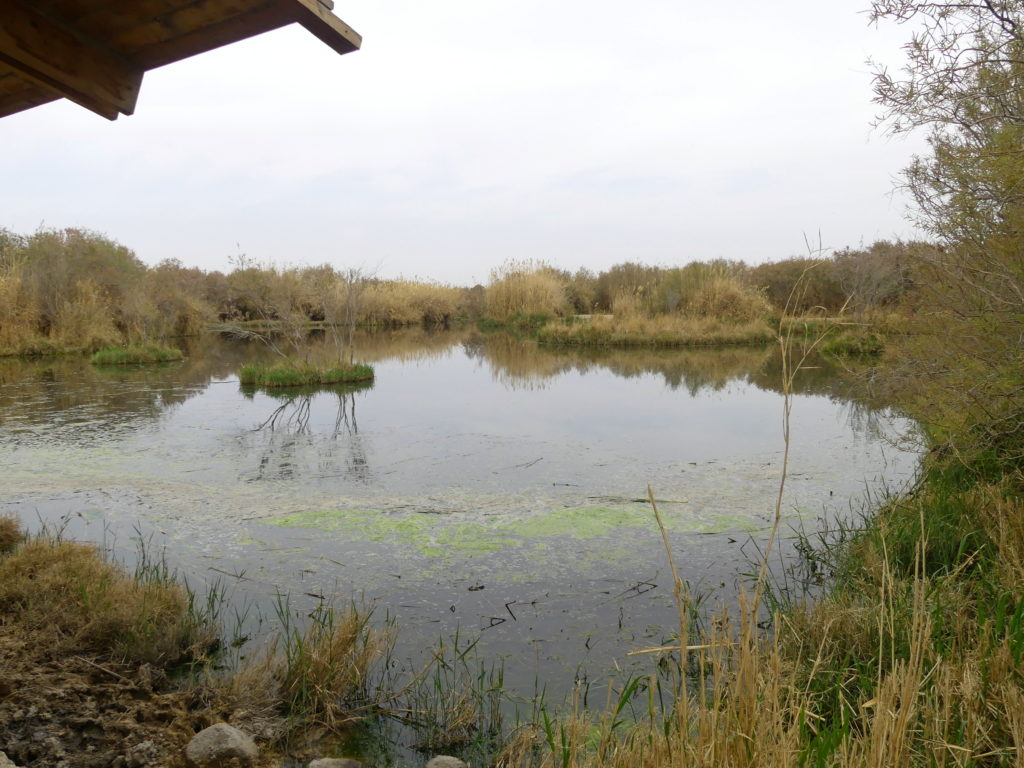
Only a few sections like this remain in the wetlands, much of which is either lush with reeds or dried out.
Though the migratory bird life is comparatively modest now due to the limited wetlands space, some come in droves, like this common chiffchaff.
It would be only a memory except for forty years of work by the admirable RSCN (Royal Society for the Conservation of Nature) to preserve some of this important resource.
We did two walks through its Wetlands Reserve to see the rich vegetation left here and some of the birds that still come. Like this ferruginous duck enjoying a golden pond on a sunny day.
At another pond in the reserve, dribbling black-winged stilt reflected. Other males nearby were busily contending with each other for dominance.
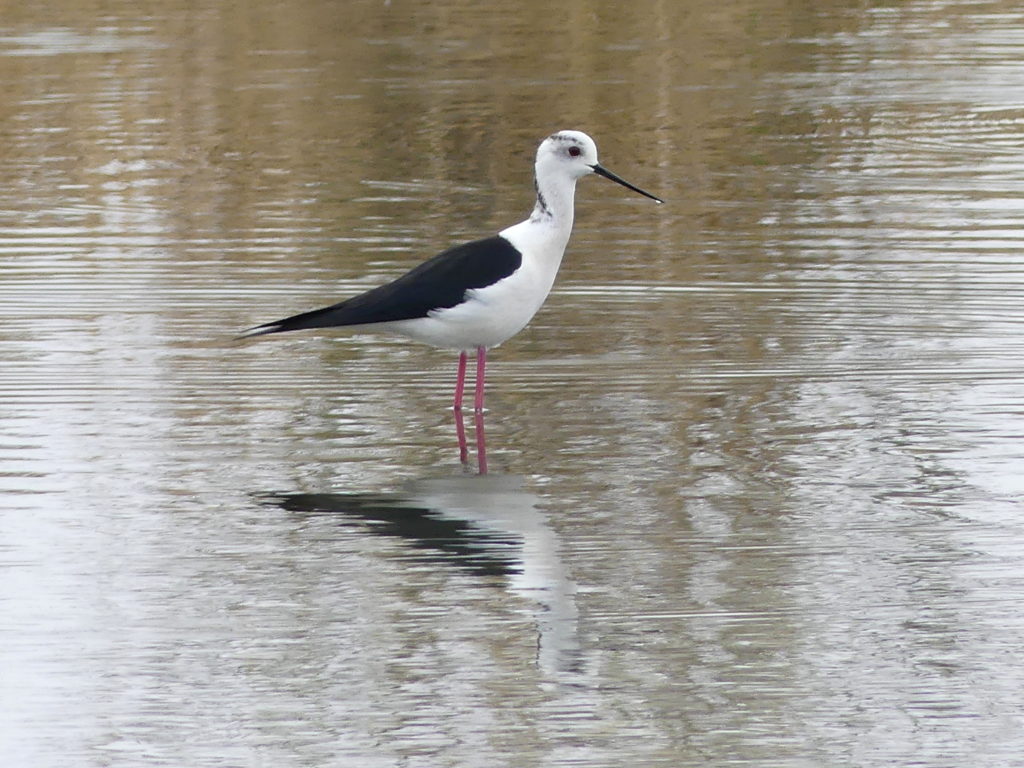
These wetland ponds were quite noisy at times, a good sign of a healthy waterway, with the croaking and burbling of frogs like these.
We also learned about the principal work done by the RSCN to restrain the outflow of water from legal and illegal drainage, holding off the further depletion of those life-giving springs within the thirsty desert.
When the water left, so did the population of water buffaloes introduced here for agricultural work in the 1920s by Chechens fleeing Soviet Russia. We saw a herd, including this baby water buffalo looking for mama nearby.
The buffalos were re-introduced in the late 1970s because their appetite for reeds could help keep the wetlands from clogging up. They seem to be doing quite well.
At the neighboring Shaumari Wildlife Reserve, we went on a jeep safari to see the handsome Arabian oryx (and some other mammals and birds). These had been plentiful at Azraq long ago; now, in the reserve, they still flourish in limited numbers.

We also glimpsed a few gazelles and honagers, a donkey-like animal, both of which were abundant in the past.
Either way, this Bluethroat made us gasp when it flew close to us at Shaumari Reserve, showing off its dazzling bib. Visually it seemed to us to be a kind of thrush, but is officially considered a flycatcher.
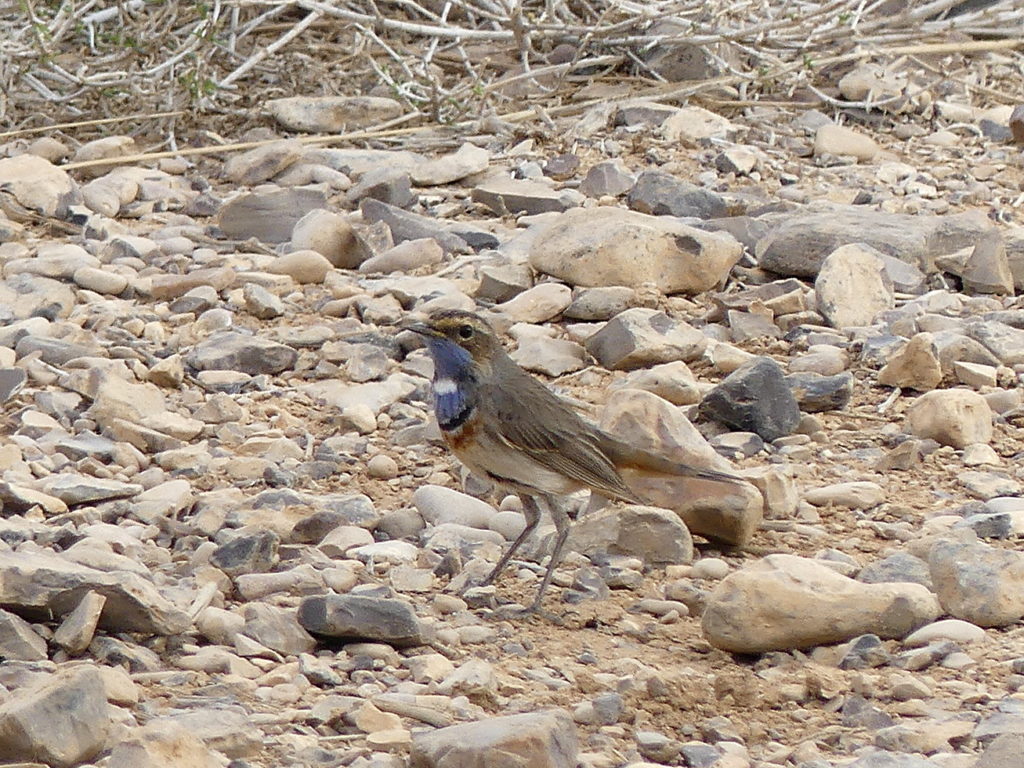
It was astonishing to learn about the other animals that once had watered on the oasis, but have disappeared completely from Jordan: lions, rhinoceros, hippopotamus, elephants, cheetah, ostrich, and even the wild ass.
Near the wetlands, the desert landscape encircling Azraq shows why the oasis was highly prized by man and animal over the millennia.
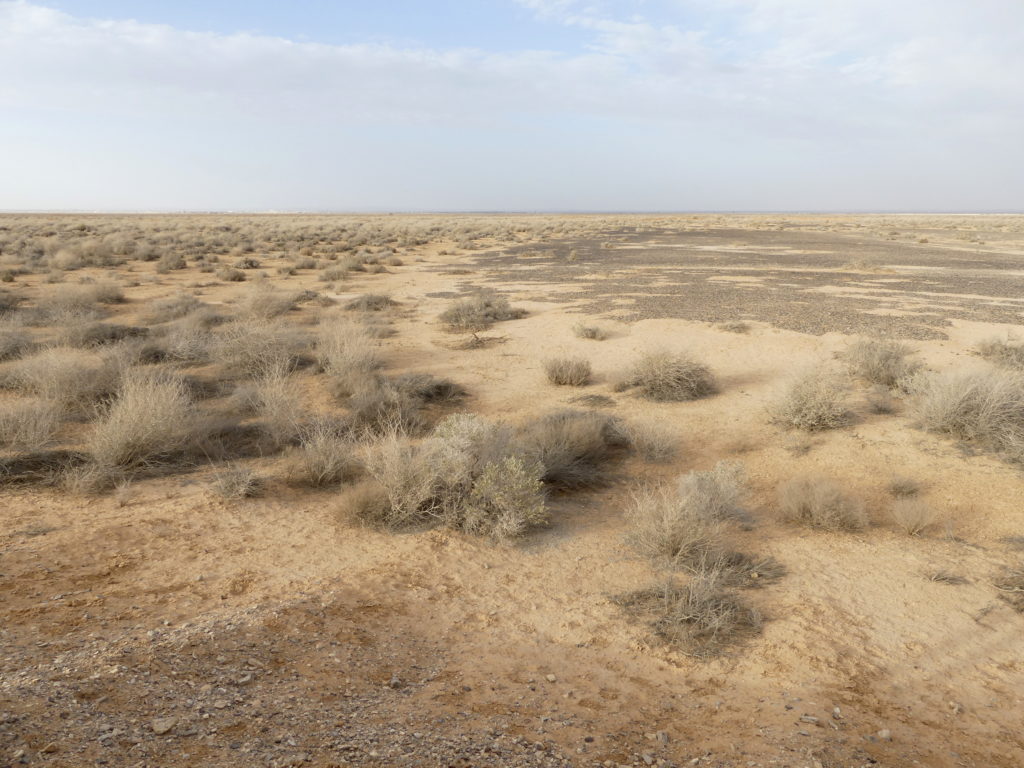
(To enlarge any picture above, click on it. Also, for more pictures from Jordan, CLICK HERE to view the slideshow at the end of the itinerary page.)



